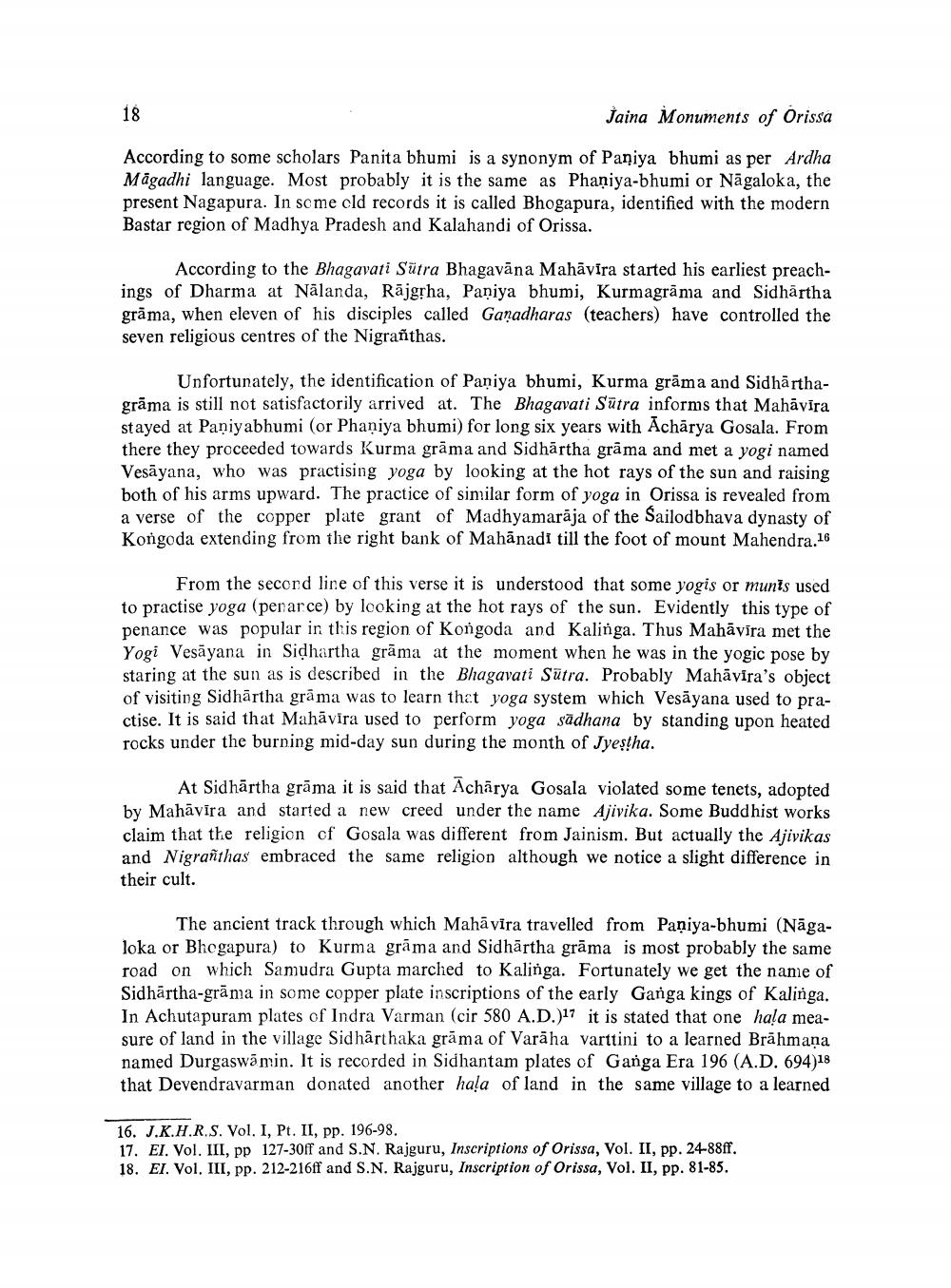________________
Jaina Monuments of Orissa
According to some scholars Panita bhumi is a synonym of Paniya bhumi as per Ardha Māgadhi language. Most probably it is the same as Phaniya-bhumi or Nāgaloka, the present Nagapura. In some cld records it is called Bhogapura, identified with the modern Bastar region of Madhya Pradesh and Kalahandi of Orissa.
According to the Bhagavati Sütra Bhagavāna Mahāvira started his earliest preachings of Dharma at Nālanda, Rājgļha, Paniya bhumi, Kurmagrāna and Sidhartha grāma, when eleven of his disciples called Ganadharas (teachers) have controlled the seven religious centres of the Nigrañthas.
Unfortunately, the identification of Paniya bhumi, Kurma grāma and Sidhārthagrāma is still not satisfactorily arrived at. The Bhagavati Sūtra informs that Mahāvīra stayed at Paniyabhumi (or Phaniya bhumi) for long six years with Acharya Gosala. From there they proceeded towards Kurma grāma and Sidhārtha grāma and met a yogi named Vesāyana, who was practising yoga by looking at the hot rays of the sun and raising both of his arms upward. The practice of similar form of yoga in Orissa is revealed from a verse of the copper plate grant of Madhyamarāja of the Sailodbhava dynasty of Kongoda extending from the right bank of Mahānadi till the foot of mount Mahendra.16
From the secord line of this verse it is understood that some yogis or munts used to practise yoga (penarce) by looking at the hot rays of the sun. Evidently this type of penance was popular in this region of Kongoda and Kalinga. Thus Mahāvīra met the Yogi Vesāyana in Sidhartha grāma at the moment when he was in the yogic pose by staring at the sun as is described in the Bhagavati Sutra. Probably Mahāvira's object of visiting Sidhārtha grāma was to learn that yoga system which Vesāyana used to practise. It is said that Mahāvīra used to perform yoga sadhana by standing upon heated rocks under the burning mid-day sun during the month of Jyestha.
At Sidhartha grāma it is said that Achārya Gosala violated some tenets, adopted by Mahāvīra and started a new creed under the name Ajivika. Some Buddhist works claim that the religion of Gosala was different from Jainism. But actually the Ajivikas and Nigranthas embraced the same religion although we notice a slight difference in their cult.
The ancient track through which Mahāvira travelled from Paniya-bhumi (Nāgaloka or Bhegapura) to Kurma grāma and Sidhārtha grāma is most probably the same road on which Samudra Gupta marched to Kalinga. Fortunately we get the name of Sidhārtha-grāma in some copper plate inscriptions of the early Ganga kings of Kalinga, In Achutapuram plates of Indra Varman (cir 580 A.D.)17 it is stated that one hala measure of land in the village Sidhārthaka grāma of Varāha varttini to a learned Brāhmaṇa named Durgaswā min. It is recorded in Sidhantam plates of Ganga Era 196 (A.D. 694)18 that Devendravarman donated another hala of land in the same village to a learned
16. J.K.H.R.S. Vol. I, Pt. II, pp. 196-98 17. EI. Vol. III, pp 127-30ff and S.N. Rajguru, Inscriptions of Orissa, Vol. II, pp. 24-88ff. 18. EI. Vol. III, pp. 212-216ff and S.N. Rajguru, Inscription of Orissa, Vol. II, pp. 81-85.




